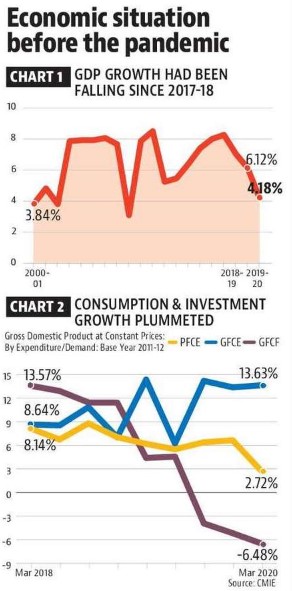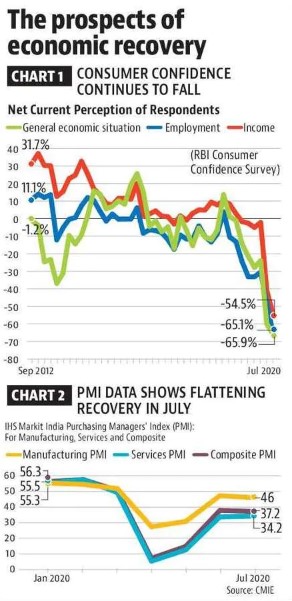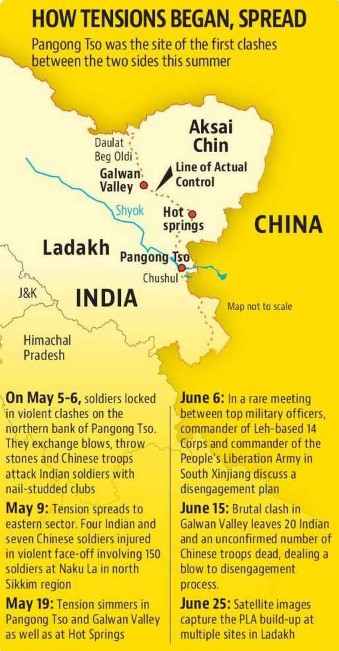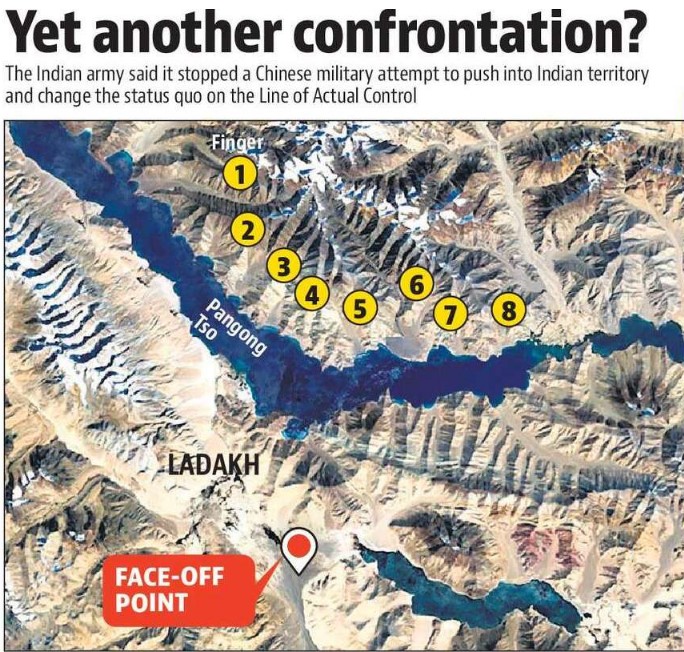Contents
- GDP contracts by record 23.9% in Q1: Full Coverage
- Adivasis account for 13% of total convicts
- Aggressive moves by China near Pangong Tso
GDP CONTRACTS BY RECORD 23.9% IN Q1: FULL COVERAGE
Focus: GS-III Indian Economy
Why in news?
- The Indian economy saw its worst contraction in decades, with Gross Domestic Product (GDP) shrinking by a record 23.9% in the April to June quarter (Q1FY21) in comparison to the same period last year, according to data released by the National Statistical Office (NSO).
(The numbers are the first estimates and they could be revised downwards further – This is because, the informal sector numbers, which are likely to have suffered more, will only become available at a later stage).
- The contraction reflects the severe impact of the COVID-19 lockdown, which halted most economic activities, as well as the slowdown trend of the economy even pre-COVID-19.
- Economists expect this to contribute to a contraction in annual GDP this year, which may be the worst in the history of independent India.
Pre-Covid times
- The Indian economy was in one of its worst ever deceleration phases even before the Covid-19 pandemic.
- GDP growth fell continuously for eight quarters (except for a 0.08 percentage point blip between December 2018 and March 2019.
- It was 8.2% in March 2018 and had fallen to just 3.1% in March 2020.

Both current and future drivers of growth collapsed
- Consumption demand is the biggest driver of economic growth in India.
- In 2019-20, Private Final Consumption Expenditure (PFCE) had a share of 57% in India’s GDP.
- Given the strengthening headwinds to consumption demand, firms started shelving investment plans.
- This can be seen in Gross Fixed Capital Formation (GFCF) contracting at an increasing rate for three consecutive quarters ending March 2020.
- A collapse in investment demand has adverse implications for future growth potential of the economy.
- It was only government expenditure which was acting as a counter-cyclical force to some extent.
The Current Lockdown Phase
- India was under an almost complete lockdown for the months of April and May.
- Some experts say: The lockdown was not the problem, but it is the manner in which it was implemented and the policy response which has followed that have made things worse.
- The economic contraction has affected the entire non-farm economy including the government sector.
Highlights
- The last contraction of the economy occurred in 1979-80, when GDP shrank 5.2%. There have been four other instances of minor contraction between 1965-68, and 1972-73, but this year is likely to be the worst since Independence.
- The steepest fall came from the 50% in construction, and 47% fall in trade, hotels, transport and communication. Manufacturing shrank more than 39%, while mining and quarrying dropped 23%.
- “The major burden on the economy is the contraction you are seeing in private final consumption, which has a weight of almost 60% in the GDP.
- Agriculture was the only silver lining with a growth of 3.4%.
- Gross Value Added (GVA), which measures the value of production minus taxes contracted by 22.8%.
- The expenditure side numbers suggest that both consumption and investment demand collapsed during the lockdown.
- Private Final Consumption Expenditure contracted by 26.7%.
The Decline and Prospect of Recovery

- While lockdown restrictions have been eased significantly from July onwards, the continuous rise in the number of Covid-19 infections has led to a continuous deterioration in consumer sentiment- as seen in RBI’s latest consumer confidence survey conducted.
- The worsening economic outlook, according to experts, will generate additional headwinds for consumption demand as households increase precautionary savings.
- High frequency indicators also suggest that some of the recovery seen in June might have been the result of pent-up demand due to the lockdown in April and May.
- Prospects of a co-ordinated fiscal stimulus will become difficult given the disproportionate hit to finances of state governments.
- Railway freight traffic, is often times a good indicator of economic activity, an in July 2020 it is 95% of the level that it was in 2019.
- Power consumption is only 1.9% lower than in 2019.
- The GDP contraction can be put in the context of a global recession due to COVID-19 according to the Indian Chief Economic Advisor.
RBI’s plan to rescue
- In a bid to cool rising bond yields and maintain market stability in the financial system, the Reserve Bank of India (RBI) announced a slew of measures including two more tranches of special open market bond operations or ‘Operation Twist’ and additional term repo operations of Rs 1 lakh crore at a floating rate basis.
- The RBI also reiterated that it “remains committed to use all instruments at its command to revive the economy by maintaining congenial financial conditions, mitigate the impact of COVID-19 and restore the economy to a path of sustainable growth while preserving macroeconomic and financial stability.”
- The RBI has allowed an additional 2.5 per cent of deposits for banks as HTM for the second half of the current financial year (September – March).
- The RBI said that there will be another set of ‘Operation twists’ where it will buy and sell securities of different maturities to manage yields in the market.
- There will also be a term repo auction in mid-September to address the issue of advance tax payments.
Operation Twist
- ‘Operation Twist’ is when the central bank uses the proceeds from sale of short-term securities to buy long-term government debt papers, leading to easing of interest rates on the long term papers.
- The name “Operation Twist” was given by the mainstream media due to the visual effect that the monetary policy action was expected to have on the shape of the yield curve.
- If we visualize a linear upward sloping yield curve, this monetary action effectively “twists” the ends of the yield curve, hence, the name Operation Twist.
- To put another way, the yield curve twists when short-term yields go up and long-term interest rates drop at the same time.
- This is expected to lead to a flattening of the yield curve. Long-end rates are expected to come off, while short-term rates could rise
-Source: The Hindu, Hindustan Times, Business Standard
ADIVASIS ACCOUNT FOR 13% OF TOTAL CONVICTS
Focus: GS-I Indian Society, GS-II Governance
Why in news?
The makeup of the present criminal justice system points to a bias against Scheduled Tribes or Adivasis, who accounted for around 13 per cent of total number of convicts and 10 per cent of the total under-trials in Indian prisons, despite comprising less than 9 per cent of the total Indian population, showed data from the National Crime Records Bureau in its prison statistics report.
Details
- This number did reduce by a small margin, compared to data from 2001, that showed 15.2 per cent and 13.2 per cent of the total convicts and under-trials respectively were Adivasis.
The Possible reasons?
- Depending on the category of forest, taking a twig can become a crime as well – but these laws that make accusations easy are actually obsolete with the coming of the Forest Rights Act, 2006.
- Some lawyers argue that a disproportionate amount of power was held by forest department officials, whether under provisions of the Indian Forest Act, 1927, state forest laws or the Wildlife Protection Act, 1972.
- Forest department officials have the powers for search and seizure, arrest, investigation, determination of fines and compounding offences, in the case of forest offences.
- Trials in such offences can go on for a year or more, with Adivasis not getting access to proper legal aid.
- Most forest cases do not reach courts as the matters are ‘settled’ by forest department officials.
- The court directs a punishment — usually a fine — on the spot with no further ado, if the accused pleads ‘guilty’, with the alternative being a long incarceration during the trial.
Pointers
- While most colonial laws underwent rigorous scrutiny and significant reform under the Constitution, this was not the case with forest laws.
- India had not ratified the International Labour Organization’s Convention 169 — concerning indigenous peoples and tribal peoples — that formed a large body of international law instruments that can protect Adivasis within the Indian judicial system.
-Source: Down to Earth
AGGRESSIVE MOVES BY CHINA NEAR PANGONG TSO
Focus: GS-II International Relations
Why in news?
In an escalation of the ongoing standoff on the border in Ladakh, Chinese troops carried out aggressive moves to change the status quo on the South Bank of Pangong Tso and those attempts have been thwarted said the Indian Army.
Details
- PLA troops violated the previous consensus arrived at during military and diplomatic engagements during the ongoing standoff in Eastern Ladakh and carried out provocative military movements to change the status quo.
- Indian troops pre-empted this PLA activity on the Southern Bank of the Pangong Tso Lake, undertook measures to strengthen our positions and thwart Chinese intentions to unilaterally change facts on ground.
- A Brigade Commander-level flag meeting was in progress at Chushul to resolve the issues.
- There is already massive buildup of troops in the area by both the sides.

Background
- The standoff in Ladakh has been ongoing since early May and several rounds of military and diplomatic talks have failed to end the impasse.
- China has undertaken massive mobilisation along the LAC, and PLA troops have built structures inside Indian territory at several locations.
- The first phase of disengagement undertaken in early July remains incomplete with disengagement completed at Galwan valley and Patrolling Point (PP) 15 in Gogra-Hot springs area.
- Chinese troops have only moved back from the base of Finger 4, the mountain spur, to Finger 5 but remain to occupy the ridgelines of Finger 4 where India’s claim extends till Finger 8, while it has always held till Finger 4.

China controls 1,000 sq. km of area in Ladakh
- About 1,000 square kilometres of area in Ladakh along the Line of Actual Control (LAC) is now under Chinese control, intelligence inputs provided to the Centre suggest.
- From Depsang Plains to Chushul there had been a systematic mobilisation by the Chinese troops along the undefined LAC.
- Chinese forces are occupying a considerable area from Finger 4 to 8 near Pangong Tso (lake).
- The distance between Finger 4-8, the mountainous spurs abutting the lake, is about eight km.
- The stretch was patrolled both by India and China till May and India considers it to form part of its perception of the LAC.
-Source: The Hindu





